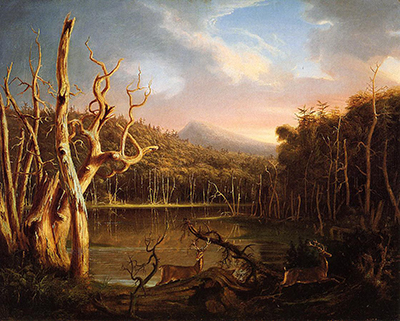Lake with Dead Trees, an 1825 oil on canvas painting, was executed by Thomas Cole. It depicts a scene in the southeastern New York State-based Catskill Mountains and is one of the 5 1825 landscapes by Cole to found the mid-nineteenth century American art movement called the Hudson River School.
The painting resides at the AMAM (Allen Memorial Art Museum), located in Oberlin, Ohio, where it's run by Oberlin College after Charles F. Olney donated it in 1904. The eye of the viewer is first drawn to the stand of snags highlighted clearly by warm morning light. These are skeletal, stripped of bark, of leaves, of any branch that cannot bend. They also embody death and are surrounded by life. In the painting, the trees are twisted and splintering apart at the centre as if by a great ravaging storm.
The raw, exposed wood is shining sun-bleached in colours of white, yellow and grey, which are the only darker pigments that have been used to illustrate shadow casts cast by the light from the topmost right side of the picture. Following vibrant trees that are seen along the base of the painting, and along the lakeside, there's further proof of a great storm. The downed, fallen trees lie by nutrient-rich soil, sunlight and water, conditions in which the trees around thrive.
As the observer's gaze moves from the bottom left side of the painting, there is a scene of destruction evoking emotions of regret and loss. Moving upwards to the right of this picture and across the sky, viewpoints start shifting with the variation in light. On the left side of the picture, the dead trees are noticeable, as evident by their proximity and size. From the left side to the right side, the sky becomes clear from a ruminating storm and to the respite of the clearing sky. As the scene starts moving to the right side, the dead trees get smaller, they diminish in importance, fading and giving way to new life and living trees.
Each of these transitions is smooth and natural motions across vivid spectrums of extremes until viewers' eyes are caught and interrupted by the 2 deer that are crossing the painting. The deer are captured in the pristine, graceful scene and appear overly poised while lacking the fluidity found in other places. In 1825, a contemporary viewer noted that the artist might have decided to omit the 2 deer because they diverted from the foreground.
The dimensions of this painting (27 by 33 3/4 inches) make it suggestive of a picture window that's offering a doorway to the NY-based Catskill mountains. Lake with Dead Trees does not present a particular moment in time, rather the painting exists. It seems to depict that withing the fragile balance of life and beauty, there's also a strength that slowly rises and reclaims where ruin had set foot.




